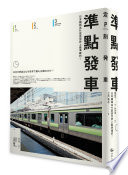
I’ve been wanting to read a book about trains. Why? Because while trains use essentially the same technology worldwide, the user experience varies dramatically from country to country. That difference isn’t technical—it’s cultural. The book 定刻発車―日本の鉄道はなぜ世界で最も正確なのか? (“Depart on Time: Why Japanese Railways Are the World’s Most Punctual”) explores the historical and cultural factors behind Japan’s railway system.
Here are some of my favorite takeaways:
The Origins of Punctuality
One of the book’s most surprising insights is that Japan’s famed train punctuality didn’t start with trains. It goes all the way back to the Edo period, 400 years ago, when people coordinated daily life without clocks. Monks rang temple bells on time, guards followed strict shift rotations, and travelers gathered at prearranged hours. Punctuality was already a deeply embedded cultural norm—long before timetables existed.
When Tokyo began its rapid urban expansion, the train system couldn’t just add more tracks—land was too scarce. So it scaled through coordination: reducing departure intervals, speeding up boarding and alighting, and optimizing schedules to a near-surgical level. It’s a story not of building bigger systems, but of making tighter ones.
The Trade-off: Efficiency vs. Resilience
The efficiency of Japan’s train system is often praised, but it comes at a cost: resilience. With fewer buffer tracks and tighter schedules, even a minor delay can snowball into major congestion. The system excels under normal conditions, but it’s less forgiving when disruptions occur.
A striking example is a day at Shinjuku Station, one of the world’s busiest. It’s a marvel of scalability—but also a case study in fragility. A 10-minute delay can overwhelm the platforms with people. The system is high-throughput, low-buffer—extremely efficient, but tightly wound.
Rails and Economics
The author approaches railways not as a train enthusiast, but as an economist. What fascinates them is how trains, like markets, are systems for managing expectations.
Both railways and economies are open systems with countless users. Small, local changes can lead to global instability. Both require stabilizers—prices in markets, operation plans in railways. And both are shaped by how people predict and respond to change.
The Invisibility of Modern Systems
The preface presents a powerful idea: modern life is run by systems we can’t see. You can’t photograph an email being sent. We live inside black boxes—acting within systems whose inner workings remain opaque.
One haunting theme is this loss of visibility in everyday life. A generation ago, children could understand the world simply by walking through their village—seeing the baker, the carpenter, the policeman. Today, buildings arrive prefabricated. Infrastructure and services operate behind layers of abstraction.
The book argues that even the train—once a visible and tangible machine—is now part of this complexity. As the systems around us grow more opaque, people begin to lose sight of their own contribution to the world—and with it, their sense of purpose.
The Train Driver’s Zen
Train drivers don’t sleep when they want; they sleep when the timetable allows. And their only moment of calm? When they’re actually driving—in sync with the machine, supported by a trustworthy system and fellow workers. There’s something poetic in that harmony between human and system.
Trains Are Predictive Systems
Timetables aren’t static—they’re constantly updated based on predictive data. Train planners adjust operations by monitoring ticket bookings, gate traffic, new residential and commercial developments, festivals, and even events like the Olympics. The system listens to the city.
The Human Future of Rail
In the past, passengers had to adapt to the train. Now, technology helps trains adapt to the passenger. With smartphones and real-time updates, people find their own way around delays. In the future, passengers won’t be treated as a “flow,” but as individuals.
That also means making the workplace more inclusive—welcoming not just career men, but women, seniors, and foreign workers. The next-generation rail system must be not only efficient, but humane.
My Quick Summary
This book tells a rich story of historical path dependence and cultural coordination. Interestingly, market structures (like monopolies or competition) and legal factors barely feature. This suggests a kind of structural inertia—a lack of short-term agency. You can’t just send a Japanese rail crew abroad to “fix” another country’s system. Changing the culture is slow, difficult work.
Let’s see how the Japanese bullet train project in Texas goes. Will the system bend around local culture—or the other way around?
Edited with ChatGPT 4o